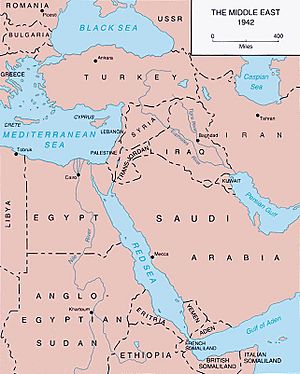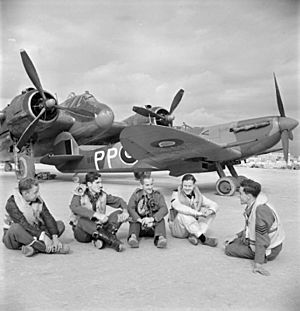Mediterranean and Middle East theatre of World War II facts for kids
Quick facts for kids Mediterranean and Middle East theatre |
|||||||||
|---|---|---|---|---|---|---|---|---|---|
| Part of the Second World War | |||||||||
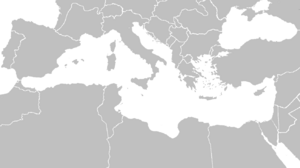 A map of the Mediterranean in 1941 |
|||||||||
|
|||||||||
| Belligerents | |||||||||
|
|
||||||||
| Commanders and leaders | |||||||||
The Mediterranean and Middle East Theatre was a huge area where many battles of the Second World War took place. This theatre included the Mediterranean Sea, North Africa, the Horn of Africa, the Middle East, and Southern Europe. Countries fought on land, at sea, and in the air to control these important regions.
The fighting started on June 10, 1940, when Italy joined the war on the side of Germany. It ended on May 2, 1945, when all Axis forces in Italy gave up. However, some fighting continued in Greece for a short time after that. The British called this area the Mediterranean and Middle East Theatre. The Americans called it the Mediterranean Theater of War.
Italy wanted to create a new Roman Empire. The Allies wanted to keep things as they were. Italy attacked France and bombed Malta in 1940. Malta was under siege for over two years. Italian forces also attacked Greece, but they struggled. When German forces joined, Greece and Yugoslavia were quickly taken over.
Allied and Axis forces fought back and forth in North Africa. The fighting also spread to the Middle East, including Palestine and Iraq. The Axis powers suffered huge losses in North Africa. By May 1943, their control there ended. The Allies then invaded Italy. This led to a civil war in Italy. The battle for Italy lasted until May 2, 1945.
This theatre was the longest part of World War II. It led to the end of the Italian Empire. Germany also lost many soldiers and resources here. This greatly weakened Germany's position in the war.
Contents
Why the War Started in This Region
Italy's Goals and Ambitions
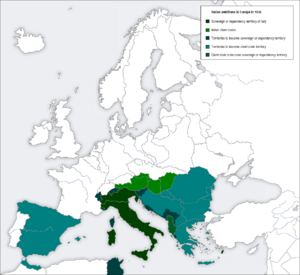
In the late 1920s, Italy's leader, Benito Mussolini, wanted Italy to expand. He said Italy needed more land for its growing population. His government wanted to control the Mediterranean and nearby regions. They dreamed of an empire like the old Roman Empire. This empire would stretch from the Strait of Gibraltar to the Strait of Hormuz.
Mussolini wanted to take over Albania, parts of Yugoslavia, and Greece. He also wanted to make countries like Austria and Hungary into friendly states. Italy's main goal was to become the most powerful country in the Mediterranean. This would allow Italy to challenge France and Britain. It would also give Italy access to the Atlantic Ocean and Indian Ocean.
In 1938, Mussolini spoke about taking over Albania, Tunisia, Corsica, and parts of France. He believed Italy needed free access to oceans and shipping routes. He called Italy a "prisoner in the Mediterranean." He wanted to break free from British and French control. This meant taking places like Malta, Gibraltar, and the Suez Canal.
In 1935, Italy invaded Abyssinia (now Ethiopia). This was called the Second Italo-Ethiopian War. Mussolini saw this as a way to get raw materials and new places for Italians to live. Soon after, Italy got involved in the Spanish Civil War. In 1939, Italy invaded and took over Albania. In May 1939, Italy officially joined with Nazi Germany in the Pact of Steel.
Britain's Role and Preparations
Britain was worried about Italy's actions. In 1937, Britain and Italy had agreed not to change any country's independence in the Mediterranean. But Italy's actions showed they did not follow this agreement. After Italy invaded Abyssinia, both British and Italian forces in North Africa grew stronger.
By July 1937, Britain decided Italy could not be trusted. Britain started to improve its defenses in the Mediterranean and Red Sea. In 1938, Britain sent more soldiers and air forces to Egypt.
In June 1939, Britain created the Middle East Command (MEC) in Cairo. This command was to control all British army units in the region. Its main goals were to protect India, keep British supply lines open, and prevent the Axis from getting Middle Eastern oil. The MEC also worked with French and Turkish military forces.
British forces were told to avoid causing trouble. After Poland was defeated, Britain feared an Axis attack from the Balkans. Britain began planning attacks in Libya and preparing Egypt for more troops. They also made plans to help the Iraqi army and support local uprisings in East Africa.
Early Military Actions
On June 10, 1940, Italy declared war on France and the United Kingdom. The next day, British Commonwealth countries also declared war on Italy. Naval battles began in the Mediterranean. The siege of Malta started on June 11 with Italian air attacks.
In the Western Desert, British planes attacked Italian positions in Libya. The Western Desert Campaign began on June 11. British forces carried out small raids. On June 17, they captured Fort Capuzzo. On June 20, Italy invaded France.
On June 22, France signed an agreement with Germany to stop fighting. On June 24, France signed a similar agreement with Italy. Italy gained a small demilitarized zone in France. The British navy attacked the French fleet in North Africa on July 3, 1940. This was to stop the French ships from falling into German or Italian hands.
When Italy joined the war, it had no plans to invade Egypt. But after France surrendered, Mussolini ordered his generals to prepare an attack. On September 9, Italian planes began bombing Egypt. Four days later, Italian soldiers attacked. They advanced to Sidi Barrani, about 80 miles west of the main British position.
In East Africa, Italy took over British Somaliland in August. In Europe, Italy invaded Greece on October 28. This started the Greco-Italian War. The Greek army fought back and pushed Italian forces into Albania.
On November 12-13, the British Royal Navy badly damaged the Italian Royal Navy in the Battle of Taranto. The British then launched a counter-attack in Egypt. This was called Operation Compass. It drove the Italians out of Egypt and destroyed their 10th Army by February 1941. After this victory, British forces took a defensive position in North Africa. Most of their troops were sent to Greece. In March, the Battle of Kufra ended with Italy losing the important desert oasis of Kufra.
Axis Victories and Expansion
North Africa: Rommel's Advance
In North Africa, Italy sent more tanks and motorized divisions after their defeat. Germany sent the Afrika Korps to help Italy. Their mission was to stop the Allies from pushing Italy out of the region. The German commander, Erwin Rommel, quickly saw that his opponents were weak. He attacked without waiting for all his forces to arrive. In March–April 1941, Rommel defeated the British forces. He forced them to retreat.
The Australian 9th Infantry Division fell back to the strong port of Tobruk. The remaining British and Commonwealth forces retreated further east to Sallum on the Libyan–Egyptian border. The main Axis force then began the Siege of Tobruk. A smaller German force pushed east, taking back all the land lost to Operation Compass. They advanced into Egypt. By the end of April, Sollum had fallen, and the important Halfaya Pass was captured.
East Africa: British Counter-Attack
In East Africa, the British attacked the Italians from Kenya Colony in February 1941. They also landed troops in British Somaliland and Italian Ethiopia. Another force moved from the Sudan towards Addis Ababa. The Italian Viceroy, Duke Amedeo d'Aosta, had to surrender by May 18. This ended the main campaign. The Empire of Ethiopia was restored under Haile Selassie. Some Italian groups continued to fight a guerrilla war until October 1943.
The Balkans: Germany's Swift Conquests

In the Balkans, Greece had been careful about letting British troops into the country. Britain could not send enough forces to guarantee victory. But Greece did accept air support from the British in their war against Italy in Albania. When it seemed Germany would attack Greece, four British divisions moved from North Africa to help the Greek Army.
In April 1941, German, Italian, Hungarian, and Bulgarian forces quickly defeated the Royal Yugoslav army. They took over Yugoslavia in 11 days. They divided it among themselves and created new states. These included the Independent State of Croatia. Italy also created a Montenegrin state and took over most of the Dalmatian coast.
A complex guerrilla uprising soon began in Yugoslavia. It was led by communist Partisans, commanded by Josip Broz Tito. Another group, the royalist Chetniks, fought the occupiers but also worked with them against the communists. The Partisans eventually became the main resistance movement recognized by the Allies. With help from the Soviets and Western Allies, they grew strong and freed their country.
After Italy's invasion of Greece in October 1940, Greece fought back with British support. When the German invasion, called Operation Marita, began on April 6, 1941, most of the Greek Army was fighting Italians in Albania. German troops invaded from Bulgaria, opening a second front. Greece received some help from British, Australian, and New Zealand forces.
The Greek army was outnumbered. The Metaxas defensive line was quickly overrun by the Germans. The Germans then surrounded the Greek forces at the Albanian border, forcing them to surrender. British, Australian, and New Zealand forces were overwhelmed. They had to retreat and were eventually evacuated.
The Germans were able to surround the Allied forces. They cut off Greek units in the east. The German advance into Greece was easier because most of the Greek Army was fighting Italians in the north. The Greeks had to surrender, ending resistance on the mainland by the end of April. The Commonwealth forces retreated to the island of Crete.
From May 20, the Germans attacked Crete using paratroopers. They suffered heavy losses but secured a landing area. They then flew in more troops and captured the island by June 1. With their victory in the Battle of Crete, the Germans secured their southern flank. They then focused on invading the Soviet Union.
Adolf Hitler later blamed Mussolini's failed invasion of Greece for delaying his invasion of the Soviet Union. However, this delay had serious consequences for the Axis war effort in North Africa.
Middle East Operations
Iraq: British Intervention
When Italy joined the war, the Iraqi government did not cut ties with them. The Italian office in Baghdad became a center for Axis propaganda. It encouraged anti-British feelings. In January 1941, there was a political crisis in Iraq. The Regent of Iraq, Prince 'Abd al-Ilah, learned of a plot to arrest him. He fled to a British air base.
On April 1, Rashid Ali and four army officers took power in a coup. Rashid Ali asked Germany for military help if war broke out with Britain. Germany secretly agreed to send military aid. They also made a deal with Vichy France to use French airbases in Syria to send planes to Iraq.
On April 30, the Iraqi Army surrounded the British air base at Habbaniya. The British sent reinforcements from Transjordan and India. The Iraqi forces were defeated. Baghdad and Mosul were captured. Ali and his supporters fled. An agreement was signed, restoring the monarchy and a pro-British government. This defeat stopped the German-Italian plan to create an Axis state in Iraq. It also worsened relations between Britain and Vichy France.
Syria and Lebanon: Operation Exporter
In Operation Exporter, Australian, Free French, British, and Indian troops invaded Syria and Lebanon from Palestine on June 8, 1941. They met strong resistance from the Vichy French forces. But the Allies had better equipment and more soldiers. By July 8, north-east Syria was captured. Negotiations for a ceasefire began on July 11, and the surrender was signed on July 14.
Iran: Securing Supply Routes
Supplies for the Soviet Union were being sent by sea. But these routes were dangerous. Allied planners wanted to open another supply route through Iran. The Shah of Iran was seen as pro-German by the Allies. When he refused to open Iran as a supply route, the Allies invaded and occupied Iran in August 1941.
The Shah was removed from power. His young son was placed on the throne as a leader under Allied control. Iranian oil fields were secured. The supply line to Russia was established and used for the rest of the war.
Gibraltar and Malta: Key Strongholds
Gibraltar controlled the entrance to the Mediterranean Sea. It had been a British fortress for a long time. It had a strong harbor for ships. Force H was based in Gibraltar. Its job was to keep naval control and protect convoys going to and from Malta.
Malta was only about 60 miles from Sicily. It was one of the first targets for the Italian army and air force. At first, Malta's air defense had only six old planes. But after the first Italian air attacks, it became clear Malta could be defended. More fighter planes were sent to Malta.
German submarines also began operating in the Mediterranean in September 1941. They attacked British supply convoys going to Malta and Tobruk. More submarine bases were set up in Italy.
Heavy bombing and a naval blockade caused food and supply shortages on Malta. Rationing was put in place. German air forces also joined the bombing. But when the bombing slowed down in early 1942, 61 new fighter planes arrived. This greatly improved Malta's defenses.
Supply runs during quiet times kept Malta going. The island's defense was very important for the Allies. As the garrison recovered from bombings, their planes and submarines attacked Axis supply ships. This caused fuel and supply shortages for Axis forces in Libya.
Allied Counter-Attacks
North Africa: Turning the Tide
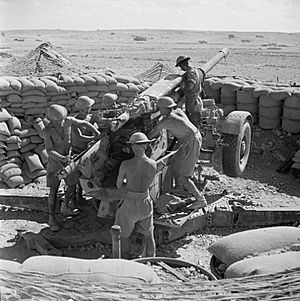
In 1941, the British launched several attacks to push back the Axis forces in North Africa. Operation Brevity and Operation Battleaxe failed. But Operation Crusader, a larger attack, was launched at the end of the year. From December 1941 to early 1942, Allied forces pushed the Italian-German forces back through Libya.
The German forces then counter-attacked. They pushed the Allies back to Gazala, west of Tobruk. Both sides prepared for new attacks. The Axis forces struck first and badly defeated the Allies in the Battle of Gazala. The defeated Allied forces retreated to Egypt. They made a stand at El Alamein.
After the First Battle of El Alamein stopped the Axis advance, British forces attacked in October. The Second Battle of El Alamein was a major turning point in the North African Campaign. It ended the Axis threat to Egypt, the Suez Canal, and the Middle Eastern oil fields.
As the British Eighth Army moved west, German forces occupied southern France and landed in Tunisia. On November 8, Allied forces launched Operation Torch. They landed in various places across French North Africa. In December 1942, French Somaliland fell to the Allies after a British blockade.
US Joins the Fight
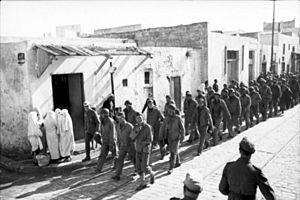
After the Japanese attack on Pearl Harbor on December 7, 1941, the United States joined the war. On November 8, 1942, American forces entered combat in North Africa with Operation Torch. This made the Mediterranean a shared Allied war zone.
Allied forces were led by General Dwight D. Eisenhower. Axis forces were trapped between the Allied armies during the Tunisia Campaign. They tried to delay the Allied advance with defensive operations. Key battles included the Battle of the Kasserine Pass.
After breaking the Axis defenses, the Allies pushed Axis forces into a small area around Tunis. Axis resistance in Africa ended on May 13, 1943. Nearly 240,000 Axis soldiers became prisoners of war.
Southern Europe: Italy and Beyond
The Italian Campaign and Civil War
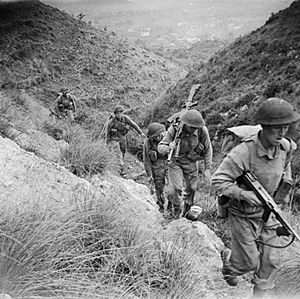
After winning in North Africa, the Allies invaded Sicily on July 10, 1943. This was Operation Husky. The Germans could not stop the Allies from taking the island. But they moved most of their troops and equipment to mainland Italy. On July 25, the Italian government removed Mussolini from power, and he was arrested. The new government said it would continue the war, but secretly began talking with the Allies.
The Allied invasion of Italy began on September 3, 1943. The British Eighth Army landed in southern Italy. The Italian government signed a surrender agreement the same day. The Allies announced the surrender on September 8. German forces then began to occupy Italy. On September 9, American and British forces landed at Salerno.
The Germans could not stop the Italian fleet from sailing to Malta. German forces quickly disarmed and captured Italian troops in southern Europe and the Mediterranean. On September 16, a German force rescued Mussolini from where he was being held. A puppet government led by Mussolini was then set up in northern Italy.
The Italian Co-Belligerent Army was formed to fight against Mussolini's government and its German allies. Other Italian troops continued to fight with the Germans. This period is known as the Italian Civil War. The fighting between Italians was very intense.
The campaign in Italy was difficult because of the rough terrain. It was good for defense. The Allies slowly pushed the Germans north. The German defensive line, called the Winter Line, stopped the Allied advance in late 1943. Operation Shingle, an attack behind the line, did not work as planned. The line was finally broken in the Fourth Battle of Monte Cassino in spring 1944. Rome was captured in June.
After Rome fell, the Italian campaign became less important. The Normandy landings in June 1944 and Soviet victories on the Eastern Front became the main focus. The Gothic Line north of Rome was not broken until the Spring offensive of 1945. On May 2, 1945, German forces in Italy surrendered to the Allies.
Dodecanese Campaign: Island Battles

This short campaign took place in the Italian-held Dodecanese Islands. Both Germany and the Allies rushed to occupy them after Italy surrendered in September 1943. German forces quickly secured the main island of Rhodes. But British forces set up garrisons on most other islands.
However, Germany had better air power and tactics. The Allies did not send enough reinforcements. German forces, including paratroopers, launched a counter-attack. They captured the island of Kos in two days in early October. A huge 50-day air campaign was launched against the island of Leros. Italian troops defended it bravely. British support troops arrived, but the Germans invaded by sea and air on November 12. Leros surrendered four days later. The remaining British forces were then evacuated.
Invasion of Southern France: Operation Dragoon
On August 15, 1944, the Allies launched Operation Dragoon. This was an invasion of Southern France. It was meant to help the operations in Normandy. The Allies quickly broke out of their landing areas. They spread out north and east to join up with other American forces. In early September, the forces in Southern France moved out of the Mediterranean Theatre. They became part of the fighting on the Western Front.
After the War: New Conflicts
Trieste: A City Divided
At the end of the war in Europe, on May 1, 1945, Yugoslav and Slovene troops occupied the town of Trieste. The Germans surrendered to the Allies, who entered the town the next day. The Yugoslavs had to leave the town a few days later.
Greece: Civil War Begins
Allied forces were sent to Greece in October 1944 after the Germans left. They were attacked by the leftist EAM-ELAS resistance movement. This led to clashes in Athens in December 1944. This marked the beginning of the Greek Civil War.
Syria: French Withdrawal
In Syria, nationalist protests grew in May 1945. People wanted France to leave the Levant. French forces tried to stop the protests. But many Syrians were hurt. Winston Churchill opposed France's actions. He ordered British forces into Syria. They were told to fire on the French if needed. This led to a crisis. British armored cars reached the Syrian capital, Damascus. The French were escorted to their barracks. Under political pressure, the French ordered a ceasefire. They withdrew from Syria the next year.
Palestine: Growing Tensions
Before the war, the British Mandate of Palestine faced violence between Arabs and Jews. After World War II and the UN Partition Plan, a civil war broke out between Palestinian Arabs and Jews. It lasted until Britain left the territory in May 1948. This conflict then drew in neighboring countries, starting the 1948 Arab–Israeli War.
See also
 In Spanish: Frente del Mediterráneo en la Segunda Guerra Mundial para niños
In Spanish: Frente del Mediterráneo en la Segunda Guerra Mundial para niños
- List of World War II battles
- Mediterranean U-boat Campaign (World War II)
- Military history of Gibraltar during World War II
- Timeline of the North African campaign


